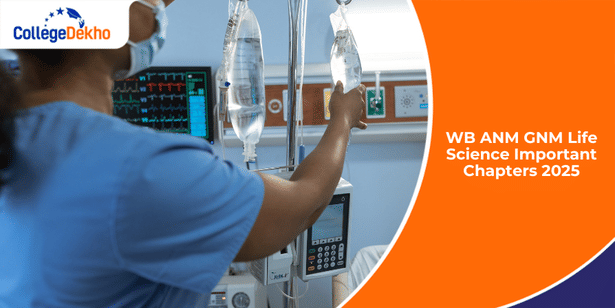- WB ANM GNM Life Science Important Chapters 2025
- Tips to Master Cellular Organization Chapter
- Chapter - Fundamental Processes
- Tips to Master Systems Physiology (Plant & Animal)
- Inheritance Biology Chapter
- Tips for Ecological Principles
- Life Science Chapter on Diversity of Life Forms
- How to learn Cell Signaling & Communication
- Application and Methods in Biology

In WB ANM GNM 2025, Life Science is the broadest subject and contains the maximum number of questions in your exam! There are many important chapters in this subject that you have to study very well for good marks. We will show you which topics from each chapter are the most important and are present in the exam every year. You will also find some example questions from each chapter that should help you practice better.
WB ANM GNM Life Science Important Chapters 2025
Here are WB ANM GNM Life Science Important Chapters 2025, which you need to focus on. Each chapter consists of scoring sub-subjects and repeated questions, which will help you maximize your concentration in preparation for marks.
Chapter | Key Subtopics to Focus On | Why It’s High-Scoring / Repeated |
|---|---|---|
Cellular Organization | Cell structure, organelles, cell division, basics of tissues | Fundamentals; many questions come from here every year |
Fundamental Processes | Photosynthesis, Respiration, Nutrition, Excretion | Links with daily life; repeated MCQs; formula/concept based |
Systems Physiology (Plant & Animal) | Circulatory, Digestive, Respiratory, Reproductive systems; Plant transport, growth | Big chunk of marks; diagrams + functions asked often |
Inheritance Biology | Mendel’s laws, DNA/RNA basics, heredity patterns, genetic diseases (basic) | Often tested with direct MCQs; less likely to be tricky if basics are strong |
Ecological Principles | Ecosystems, Food chains/webs, Pollution, Conservation, Biomes | Appears regularly; connects with GK/current affairs sometimes |
Diversity of Life Forms | Classification of plants & animals, characteristics, kingdoms, phyla basics | Helps score in taxonomy questions, which are low effort if memorized well |
Cell Signaling & Communication | Hormones, neuron basics, receptors, signaling pathways | Less frequent but high impact; some tricky MCQs come from here |
Application & Methods in Biology | Practical biology, experimental methods, microscopes, staining, biotechnology basics | Useful for Category-2 questions; also helps with MCQ accuracy |
Now that we've learned about the most important chapters in WB ANM GNM Life Science 2025, let's learn how to study each chapter step by step in an easy way with tips and example questions.
Tips to Master Cellular Organization Chapter
- Differentiate between animal and plant cell diagrams. Label all organelles and cytoplasmic inclusions such as the nucleus, mitochondria, and chloroplasts.
- Revise functions of the organelles into simple one-liners (for example, mitochondria: powerhouse; chloroplasts: photosynthesis).
- Know the types of tissues (epithelial, muscular, connective, and nervous) by everyday solutions.
- Practice differentiation (e.g., prokaryotic vs. eukaryotic; plant vs. animal cell).
- Talk about ribosomes, lysosomes, and Golgi bodies with flashcards.
Example Questions for Cellular Organization
Question | Options | Answer |
|---|---|---|
Which organelle is known as the “powerhouse of the cell”? | (a) Ribosome (b) Mitochondria (c) Nucleus (d) Golgi body | (b) Mitochondria |
Plant cells differ from animal cells due to the presence of: | (a) Lysosomes (b) Centrosomes (c) Chloroplast (d) Mitochondria | (c) Chloroplast |
Chapter - Fundamental Processes
- Focus on photosynthesis: equation, chlorophyll role, light vs. dark reaction.
- As for respiration, figure out the differences between aerobic respiration and anaerobic respiration, glycolysis, and ATP (the energy currency).
- Understand digestion basics - Mouth, stomach, and small intestine-Commands of enzymes like amylase and pepsin.
- Learn using flow diagrams (food - energy, glucose - ATP).
- Compare and contrast photosynthesis versus respiration in a simple table.
- Practice the equations (Photosynthesis: 6CO₂ + 6H₂O - C₆H₁₂O₆ + O₂).
Example for Fundamental Processes Chapter
Question | Options | Answer |
|---|---|---|
Which gas is released during photosynthesis? | (a) Carbon dioxide (b) Oxygen (c) Nitrogen (d) Hydrogen | (b) Oxygen |
The energy currency of the cell is: | (a) DNA (b) RNA (c) ATP (d) Protein | (c) ATP |
Tips to Master Systems Physiology (Plant & Animal)
- Human dissection physiology - majorly the circulatory, respiratory, digestive, excretory, nervous, and reproductive systems.
- Plant Physiology: transport (xylem/phloem); transpiration and briefly photosynthesis.
- Draw diagrams- heart, nephron, lungs, plant vascular system, label clearly.
- Make mnemonics- e.g. for cranial nerves, blood flow, or plant tissues.
- Revise often- 30-40% of Life Science questions in WB ANM GNM exams are guaranteed to come from this chapter.
Example Questions on Systems Physiology
Question | Options | Answer |
|---|---|---|
Which blood vessels carry oxygenated blood from the heart to the body? | (a) Veins (b) Arteries (c) Capillaries (d) Venules | (b) Arteries |
In plants, the xylem is responsible for transporting: | (a) Sugars (b) Water (c) Proteins (d) Minerals | (b) Water |
Inheritance Biology Chapter
- Mendelian Genetics - comprehend inheritance laws - dominant vs. recessive traits, mono- and dihybrid crosses.
- DNA & RNA - structure, function, replication, transcription, and translation.
- Flowcharts and tables - relating to gene expression, Punnett squares, types of inheritance.
- Relate to Examples - pea plants (Mendel), sickle cell anemia, blood groups.
- Revise Terms and definitions - allele, genotype, phenotype, homozygous, heterozygous.
Example Questions on Inheritance
Question | Options | Answer |
|---|---|---|
Mendel’s law of segregation explains: | (a) Separation of alleles during gamete formation (b) DNA replication (c) Protein synthesis (d) Crossing over | (a) Separation of alleles during gamete formation |
The process of making RNA from DNA is called: | (a) Replication (b) Translation (c) Transcription (d) Mutation | (c) Transcription |
Tips for Ecological Principles
- Basics of the ecosystem: understand producers, consumers, decomposers, and energy flow.
- Food chains and Food webs: draw diagrams, label trophic levels, and energy transfer efficiency.
- Biogeochemical cycles: carbon, nitrogen, and water cycles related to environmental issues.
- Population and community ecology: study population growth and carrying capacity or interactions - predation or competition.
- Current examples of environment: pollution, global warming, conservation programs in India.
Examples
Question | Options | Answer |
|---|---|---|
Which organism is a primary consumer in a food chain? | (a) Grass (b) Rabbit (c) Fox (d) Hawk | (b) Rabbit |
The process by which nitrogen is converted from atmospheric form to usable form for plants is called: | (a) Photosynthesis (b) Nitrogen fixation (c) Respiration (d) Evaporation | (b) Nitrogen fixation |
Life Science Chapter on Diversity of Life Forms
- Introduction to Classification-level study-Kingdoms, Phyla, Classes, and the main characteristics of each.
- Plant diversity-Bryophytes, Pteridophytes, Gymnosperms, Angiosperms. Their reproductive structures must be noted.
- Animal diversity-from Porifera to Chordata, with emphasis on symmetry, coelom, and digestive system.
- Use charts & diagrams- one-page classification chart serves as a quick revision.
- Repeated questions-NCERT examples on key differences between groups are commonly asked.
Example Questions
Question | Options | Answer |
|---|---|---|
Which phylum includes organisms with radial symmetry? | (a) Arthropoda (b) Cnidaria (c) Mollusca (d) Annelida | (b) Cnidaria |
Angiosperms are also called: | (a) Gymnosperms (b) Flowering plants (c) Ferns (d) Mosses | (b) Flowering plants |
How to learn Cell Signaling & Communication
- Understand basics of signaling – study types of signals: chemical, electrical, hormonal.
- Cell receptors – memorize types (G-protein, ion channel, tyrosine kinase) and their functions.
- Signal transduction pathways – focus on steps like reception, transduction, response; use simple flowcharts.
- Examples in humans – link hormones (insulin, adrenaline) to their effects for easier recall.
- Practice MCQs – most WB ANM GNM questions are direct from definitions and pathways.
Example for Cell Signaling & Communication
Question | Options | Answer |
|---|---|---|
Which of the following is a G-protein coupled receptor? | (a) Insulin receptor (b) Rhodopsin (c) Ion channel (d) Steroid receptor | (b) Rhodopsin |
Signal transduction in cells includes which step? | (a) Reception (b) Transduction (c) Response (d) All of the above | (d) All of the above |
Application and Methods in Biology
- Laboratory techniques in microscopy, stain techniques, centrifugation, and electrophoresis.
- Essentials of experimental design: hypothesis, controls, variables, interpretation of data.
- Real-world examples: focus on applications such as PCR, cloning, and even gene editing CRISPR basics in biotechnology. Examples will include agarose gel electrophoresis for DNA separation.
- Practice questions: Most MCQs are relatively direct and example-based and focus on processes and methods.
Examples on Application and Methods in Biology
Question | Options | Answer |
|---|---|---|
Which technique is used to separate DNA fragments by size? | (a) Centrifugation (b) Gel electrophoresis (c) Staining (d) Microscopy | (b) Gel electrophoresis |
What is the function of a control in an experiment? | (a) To provide variable data (b) To compare results (c) To measure pH (d) To amplify DNA | (b) To compare results |
Follow the simple study tips for each chapter and make plenty of drawings or flowcharts to aid memory. Keep studying these important topics daily till you feel confident about the exam. I know at certain times, it may get overwhelming to study all subjects together. Thus, we have a step-by-step plan for you - do check out our 30-Day Roadmap for WB ANM GNM 2025 Exam Preparation!
Are you feeling lost and unsure about what career path to take after completing 12th standard?
Say goodbye to confusion and hello to a bright future!

Was this article helpful?




















Similar Articles
Karnataka M.Sc Nursing Admissions 2026: Application Form, Dates, Eligibility, Counselling Process
Maharashtra BSc Nursing Admission 2026 - Dates, Application, Eligibility, Result
Government Jobs After ANM Nursing: Salary, Entrance Exams
Rajasthan GNM Admissions 2026: Dates, Application, Eligibility, Selection Process
Complete Admission Guide for BSc Nursing in Northeast India
Best College Options in Punjab for BSc Nursing